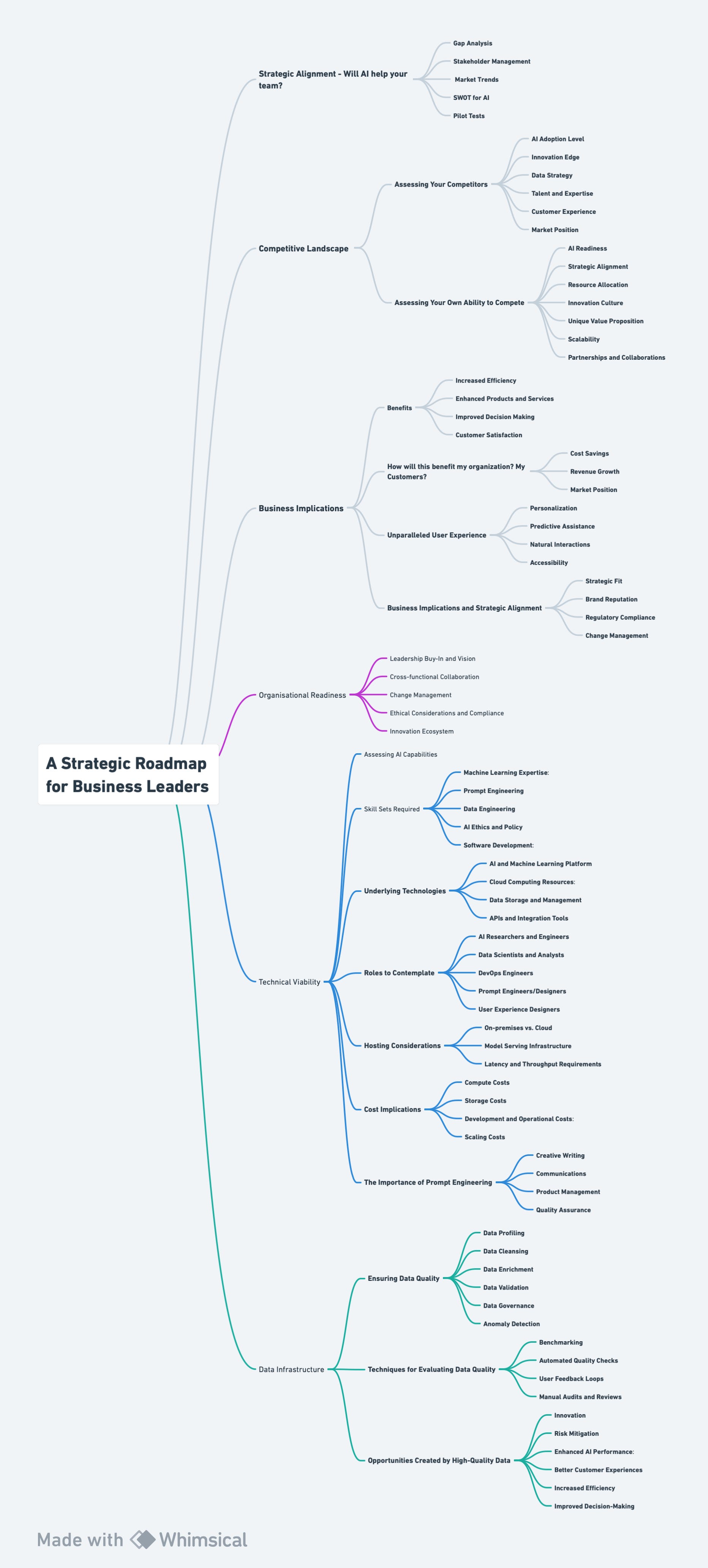🌻 🎯 Edition 22: Embracing AI - A Strategic Roadmap for Business Leaders - Part 2
A Must Read for Business Leaders.
Jumping into AI without a plan is like setting sail without a compass; you can easily drift off course. Right now, there’s a tide of companies already navigating these waters, harnessing the winds of AI to push them ahead. If you’re still on the dock, it’s urgent that you chart your course and set sail. Today, we’ll give you a decision tree—a navigational chart—to guide you through the crucial decisions, avoid the common pitfalls, and catch up with the fleet. It's a journey that’s becoming essential, and without it, you risk being left stranded while others reach new horizons. Let’s make sure you’re not just keeping up but leading the way.
Erik M. Schwartz is a seasoned Vice President of Product Management, specializing in knowledge discovery and search engine technologies with over 20 years of experience. Recently at Elsevier, Erik led the transformation of search experiences for research products and applications in academic and corporate markets. Previously, he directed the strategic evolution of search, recommendations, and content discovery platforms at Comcast Cable, and set strategic priorities for Microsoft's enterprise search strategy, focusing on global government solutions. His expertise lies in Platform as a Service (PAAS), Cross-functional Team Leadership, and Knowledge Graph-based technologies, making substantial contributions to product development and management in the tech industry.
🌻 🎯 Edition 20: Embracing AI - A Strategic Roadmap for Business Leaders - Part 1
Jumping into AI without a plan is like setting sail without a compass; you can easily drift off course. Right now, there’s a tide of companies already navigating these waters, harnessing the winds of AI to push them ahead. If you’re still on the dock, it’s urgent that you chart your course and set sail. Today, we’ll give you a deci…
✨ Organisational Readiness
Evaluating organizational readiness is a fundamental step before embarking on AI projects, particularly because such endeavors require well-aligned resources and cross-functional collaboration. Here are the key components of that an organization need to consider:
🌟 Leadership Buy-In and Vision:
Importance: Leaders must understand and champion AI initiatives. Their vision will direct the organization’s approach to AI.
Action: Secure executive sponsorship and establish a clear vision for AI in the organization, ensuring that leaders can articulate the value and implications of AI projects.
🌟 Cross-functional Collaboration:
Importance: AI projects often require input and cooperation across different parts of the organization.
Action: Foster a culture of collaboration. Create cross-functional teams that include IT, data science, business units, and other relevant departments.
🌟 Change Management:
Importance: AI can bring significant changes to business processes and roles, necessitating effective change management.
Action: Develop a change management plan that includes communication strategies, training programs, and feedback mechanisms.
🌟 Ethical Considerations and Compliance:
Importance: AI initiatives must be guided by ethical principles and comply with relevant regulations.
Action: Establish an AI ethics framework and review compliance requirements, embedding these considerations into the AI development lifecycle.
🌟 Innovation Ecosystem:
Importance: An ecosystem that supports innovation can significantly enhance an organization’s ability to leverage AI.
Action: Engage with external innovation ecosystems, such as industry consortia, academic partnerships, and technology vendors, to stay at the forefront of AI developments.
Organizational readiness for AI is multifaceted, demanding a holistic approach that integrates strategic, technical, and cultural dimensions. It requires thoughtful planning and ongoing commitment to ensure that when AI projects are initiated, they are set up for success and are capable of delivering transformative results.
✨Technical Viability
🌟 Assessing AI Capabilities
With strategic intent clarified, attention shifts to the technical domain. What are the specific capabilities of AI and machine learning, and how do they map to our business needs? This section examines the suitability of AI's analytical, predictive, and autonomous functions in the context of the company's operational and strategic objectives.
When contemplating the technical readiness for incorporating AI, and particularly Generative AI, into an organization or product, it’s crucial to consider the multifaceted nature of the undertaking. The integration spans several layers of technical expertise, underlying technologies, organizational roles, hosting considerations, cost implications, and unique skills such as prompt engineering. Here's a deep dive into these areas:
🌟 Skill Sets Required
1. Machine Learning Expertise: Engineers and data scientists with experience in machine learning algorithms are essential for designing and fine-tuning AI models.
2. Software Development: Developers skilled in integrating AI into existing systems or building new platforms are necessary.
3. Data Engineering: Professionals capable of managing and structuring the data pipelines that feed into AI systems.
4. AI Ethics and Policy: Specialists in ethical AI use and regulatory compliance to ensure the AI is used responsibly.
5. Prompt Engineering: Individuals with a blend of technical understanding of AI models and creative writing or communications skills to craft prompts that effectively guide the AI.
🌟Underlying Technologies
1. AI and Machine Learning Platforms: TensorFlow, PyTorch, and other ML frameworks are the building blocks for developing AI models.
2. Cloud Computing Resources: Platforms like AWS, Google Cloud, and Azure offer the necessary compute power and services for AI deployment.
3. Data Storage and Management: Technologies such as databases, data lakes, and data warehouses.
4. APIs and Integration Tools: To connect AI functionalities with existing systems and applications.
🌟 Roles to Contemplate
1. AI Researchers and Engineers: For developing new AI models and improving existing ones.
2. Data Scientists and Analysts: For data processing and model training.
3. DevOps Engineers: To manage the deployment and operation of AI solutions.
4. Prompt Engineers/Designers: A newer role focusing on the interaction between humans and AI, optimizing input to get the best output.
5. User Experience Designers: To ensure AI-enhanced products remain user-friendly.
🌟 Hosting Considerations
1. On-premises vs. Cloud: Decide between hosting the AI on-premises for control and security or using cloud services for scalability.
2. Model Serving Infrastructure: Whether to use platforms like TensorFlow Serving or to develop a custom solution.
3. Latency and Throughput Requirements: Ensuring the hosting solution can meet the performance demands of the application.
🌟Cost Implications
1. Compute Costs: Training and running AI models require significant processing power.
2. Storage Costs: Large datasets are necessary for effective AI, and these come with storage costs.
3. Development and Operational Costs: From salaries to software licenses, the costs span across development and maintenance phases.
4. Scaling Costs: As usage grows, so will the cost of the infrastructure to support it.
🌟 The Importance of Prompt Engineering
The role of prompt engineering is unique in that it sits at the intersection of technical know-how and creative skill. Prompt engineers must understand how generative AI thinks and responds in order to craft prompts that produce desired outcomes. It leverages disciplines such as:
1. Creative Writing: To phrase prompts that elicit rich and contextually appropriate content from the AI.
2. Communications: Understanding audience and purpose to tailor the AI's responses.
3. Product Management: Integrating the user’s needs and feedback into prompt design.
4. Quality Assurance: Testing and refining prompts to ensure consistency and quality in AI outputs.
In the context of a product team, these skills may come from diverse backgrounds such as copywriters, marketers, or technical writers who can pivot their abilities to interact effectively with AI systems.
🌻 Edition 19b: Learn ReAct - Advanced Way of Prompting - Debugging - Less Hallucination
Imagine having a conversation with someone, and just when you think you've said it all, you dive deeper into the topic, unraveling new layers of insight. It's like a dance of words and ideas. Well, guess what? Large language models (LLMs) like the ones we're going to discuss today have a similar knack. They don't just talk; they h…
✨Data Infrastructure
A practical assessment of the company's existing data infrastructure is critically important for the success of any AI project. AI's hunger for quality data is insatiable, and without the proper foundations, even the most advanced algorithms fall short. Here, the discussion revolves around the readiness of the company's data ecosystem to support an AI-driven transformation.
The axiom "garbage in, garbage out" is especially true in the context of AI and machine learning. High-quality data is the bedrock upon which reliable, insightful, and valuable AI predictions are built. Data infrastructure and data quality are thus pivotal areas of focus for any organization looking to leverage AI effectively.
A robust data infrastructure ensures that data is collected, stored, processed, and accessed efficiently. It must be:
1. Scalable: Able to grow with the organization's data needs.
2. Secure: Compliant with data privacy laws and protected against breaches.
3. Flexible: Capable of handling various data types and structures.
4. Accessible: Users and applications should have easy access to the data they need.
The infrastructure often includes data lakes, warehouses, and the use of modern data platforms like Snowflake, Redshift, or BigQuery. Streaming data platforms such as Apache Kafka or AWS Kinesis are also critical for real-time data processing.
🌟 Ensuring Data Quality
High-quality data is accurate, complete, consistent, timely, valid, and unique. To maintain these qualities, the following techniques should be considered:
1. Data Profiling: Assessing the existing data for inaccuracies or inconsistencies to understand the current data quality level.
2. Data Cleansing: Removing or correcting erroneous data points to enhance data accuracy.
3. Data Enrichment: Augmenting existing data with additional sources to fill in gaps and provide a more complete dataset.
4. Data Validation: Implementing rules that check for data integrity and constraints at the point of entry.
5. Data Governance: Establishing policies and procedures for ongoing data quality control.
6. Anomaly Detection: Using statistical methods or machine learning to identify outliers that may indicate data quality issues.
🌟Techniques for Evaluating Data Quality
Evaluating data quality involves both automated and manual processes, such as:
1. Automated Quality Checks: Software tools that can run regular audits on data for quality metrics.
2. Manual Audits and Reviews: Periodic scrutiny by data analysts to find issues that automated tools might miss.
3. User Feedback Loops: Allowing end-users to report data issues can help identify problems that internal processes do not catch.
4. Benchmarking: Comparing data quality metrics against industry standards or competitors can highlight areas for improvement.
🌟Opportunities Created by High-Quality Data
1. Improved Decision-Making: Reliable data leads to insights that can drive strategic business decisions.
2. Increased Efficiency: High-quality data reduces the need for rework and error correction.
3. Better Customer Experiences: Accurate customer data helps tailor products and services to individual needs.
4. Enhanced AI Performance: High-quality data trains better AI models, resulting in more accurate predictions and more intelligent automation.
5. Risk Mitigation: By ensuring data quality, organizations can avoid the risks associated with faulty data, such as making uninformed decisions or non-compliance with regulations.
6. Innovation: Quality data can be a source of innovation, enabling the development of new products and services that were not possible before.
Investing in data infrastructure and data quality is not merely a cost center; it’s a strategic move that empowers all facets of an organization. From sharpening competitive edges to fortifying trust in data-driven systems, the ripple effect of high-quality data cannot be overstated. Techniques to ensure and evaluate data quality should be a continuous process, ingrained within the organizational culture, to fully harness the transformative power of AI.
✨ The Decision-Making Process
Based on your exploration, several paths might emerge:
Full Integration: If every sign points to AI being a strategic powerhouse, it's time to invest heavily, ensuring you have the infrastructure, talent, and processes in place to succeed.
Partial Implementation: Not every part of your business might benefit equally from AI. Some departments might see transformative results, while others might operate better with their existing systems. Tailor your approach accordingly.
Pivot or Re-Scope: Initial findings might suggest that your original AI vision doesn't align with actual needs. Be flexible and willing to refine your strategy based on these insights.
Delay: The tech world operates at breakneck speed. If now isn't the right time due to internal or external factors, consider revisiting the decision in the future.
Abandon: There's no shame in recognizing that AI doesn't align with your current strategic needs. It's better to make this decision early than to force a misfit solution.
Seek Partnerships: Collaborations, mergers, or acquisitions might offer the expertise and resources you lack. If AI is the future for your business, but you're not equipped to venture alone, seeking partnerships can be a strategic move.
✨Next Steps
The journey of integrating AI is a strategic one, punctuated by a series of informed decisions that collectively shape the company's digital trajectory. By adhering to a decision tree framework, business leaders can navigate this path with a clarity that aligns technical possibilities with business objectives, all while upholding ethical standards and fostering an agile, collaborative culture.
AI's promise is immense, but its integration isn’t a mere checkbox on a to-do list. It's a significant shift that needs to be thoughtfully and strategically approached. By rigorously assessing alignment with company goals, businesses can harness AI's power in ways that drive sustainable growth, innovation, and competitive advantage.
Schwaa can help. https://www.schwaa.uk/
**
I will publish the next part of the series on next Sunday.
This is the 22nd Edition, If you have any feedback please don’t hesitate to share it with me, And if you love my work, do share it with your colleagues.
It takes time to research and document it - Please be a paid subscriber and support my work.
Cheers!!
Raahul
**









